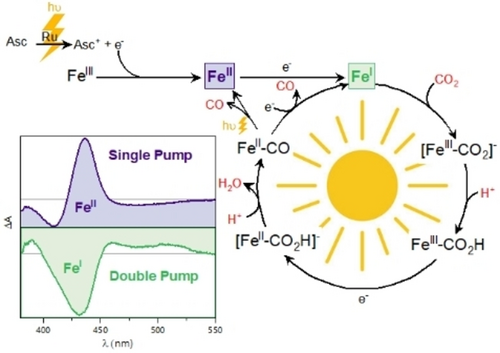Time-Resolved Mechanistic Depiction of Photoinduced CO2 Reduction Catalysis on a Urea-Modified Iron Porphyrin
Graphical Abstract
A pump-pump excitation strategy induces effective accumulation of charge on an FeIII-based urea-modified porphyrin as the fates of the photogenerated species are tracked through their optical transient absorption signatures. In the presence of CO2 as a substrate and H2O as a proton source, the two-electron accumulated species leads to CO2 activation and reduction, generating FeII-CO as a stable intermediate in the reaction mechanism.
Abstract
The development of functional artificial photosynthetic devices relies on the understanding of mechanistic aspects involved in specialized photocatalysts. Modified iron porphyrins have long been explored as efficient catalysts for the light-induced reduction of carbon dioxide (CO2) towards solar fuels. In spite of the advancements in homogeneous catalysis, the development of the next generation of catalysts requires a complete understanding of the fundamental photoinduced processes taking place prior to and after activation of the substrate by the catalyst. In this work, we employ a state-of-the-art nanosecond optical transient absorption spectroscopic setup with a double excitation capability to induce charge accumulation and trigger the reduction of CO2 to carbon monoxide (CO). Our biomimetic system is composed of a urea-modified iron(III) tetraphenylporphyrin (UrFeIII) catalyst, the prototypical [Ru(bpy)3]2+ (bpy=2,2’-bipyridine) used as a photosensitizer, and sodium ascorbate as an electron donor. Under inert atmosphere, we show that two electrons can be successively accumulated on the catalyst as the fates of the photogenerated UrFeII and UrFeI reduced species are tracked. In the presence of CO2, the catalytic cycle is kick-started providing further evidence on CO2 activation by the UrFe catalyst in its formal FeI oxidation state.
Conflict of interests
The authors declare no conflict of interest.
Open Research
Data Availability Statement
The data that support the findings of this study are available in the supplementary material of this article.





